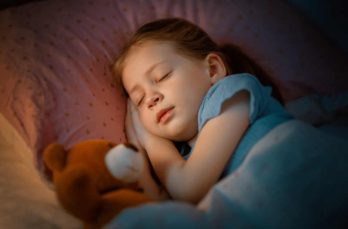Children are more likely than adults to experience nightmares and night terrors, which frequently disturbs parents’ sleep as they attempt to comfort and ease their child back to sleep. Night terrors and nightmares share many similarities, yet they can differ greatly. While nearly everyone has nightmares throughout childhood, just 1-6% of children suffer night terrors, and the experience is significantly more distressing for both parents and children. In this blog post, we’ll examine what night terrors are, the causes of them, and some strategies for dealing with them if your child has them.
Understanding Nightmares and Night Terrors
A night terror is a sleep disorder in which the subject experiences intense panic, which frequently manifests as yelling, shouting, and thrashing. Similar to sleepwalking, a youngster may occasionally move out of bed, open their eyes, and then continue to sleep. Other side effects of night terror include perspiration, faster breathing, and an elevated heart rate. After an episode, it can frequently be challenging to get a child back to sleep because of the overwhelming sense of panic. Night terrors can happen more than once per night and typically persist for several minutes, occasionally even up to 15 minutes.
The Causes of Night Terrors
A night terror often develops as a result of an interruption to a child’s deep slumber, an over-arousal of the central nervous system during sleep. Children who have a family history of sleepwalking or night terrors are more likely to experience an episode. Night terrors may also be brought on by elements that interfere with deep sleep, according to certain theories. One trigger may be an increase in deep sleep, which may be brought on by factors including fatigue, fever, or medicine. Another possibility is when this phase of sleep is disturbed, frequently as a result of stress, excitement, loud noises, or the desire to use the restroom.
What Should I Do if My Kid Has Night Terrors?
When your child has a night terror, it can be a scary experience because you always want to see them sleeping peacefully. However, the best course of action when dealing with one that is already underway is to wait patiently for it to pass while watching out for your child or daughter’s safety. Though you might be tempted, it’s best to refrain from awakening your child while they are having an episode. After a few minutes, most kids will go back to their regular slumber, so if you wake them up abruptly, they could get disturbed and less likely to fall back asleep. Furthermore, it’s doubtful that they would recall the incident, thus waking them awake will simply make them feel uneasy. You can wake up your child once the episode has ended and they have calmed down.
To assist them reset their sleep and prevent them from relapsing into a night terror, make sure they are fully awake and, if required, take them to the bathroom. Although there is no proven cure for night terrors, there are several things you can do to help your kid go asleep and address the underlying causes:
- Assist them in managing stress: Like adults, kids might experience tension and worry before bed, which can exacerbate night terrors. Find out what’s causing the issue and try to assist the youngster in resolving it; you may also try some stress-reduction strategies.
- Create a calming bedtime routine: While we’ve written on relaxing bedtime routines for adults, much of the same guidance also applies to children. Making sure they consume healthy foods and liquids, limiting computer time before bed, encouraging them to take a hot bath, and reading a tale aloud are all helpful strategies for easing children into sleep.
- Stop them from getting too tired: Night terrors are frequently preceded by being overtired, so it’s a good idea to keep an eye on your child’s routine to ensure that they aren’t overexerting themselves and are getting enough rest.
- Provide creative outlets for imaginative children: Children with active, vivid imaginations are more likely to experience night terrors, so provide them with opportunities to express themselves during the day. This could be done through acting, singing, dancing, or another art form.
- Talk to them about night terrors in the proper way: The last thing you want is for your child to develop a real fear of their night terrors, so you should be careful to talk to them about their episodes in a way that doesn’t make them anxious or scared.
Even while the majority of night terrors may be treated at home, you should consult a doctor if they recur frequently or more than once a night. A medical expert should be able to determine whether there are any underlying conditions that are the root of the issues. Contact Kid’s 1st Pediatrics if you have any inquiries.




